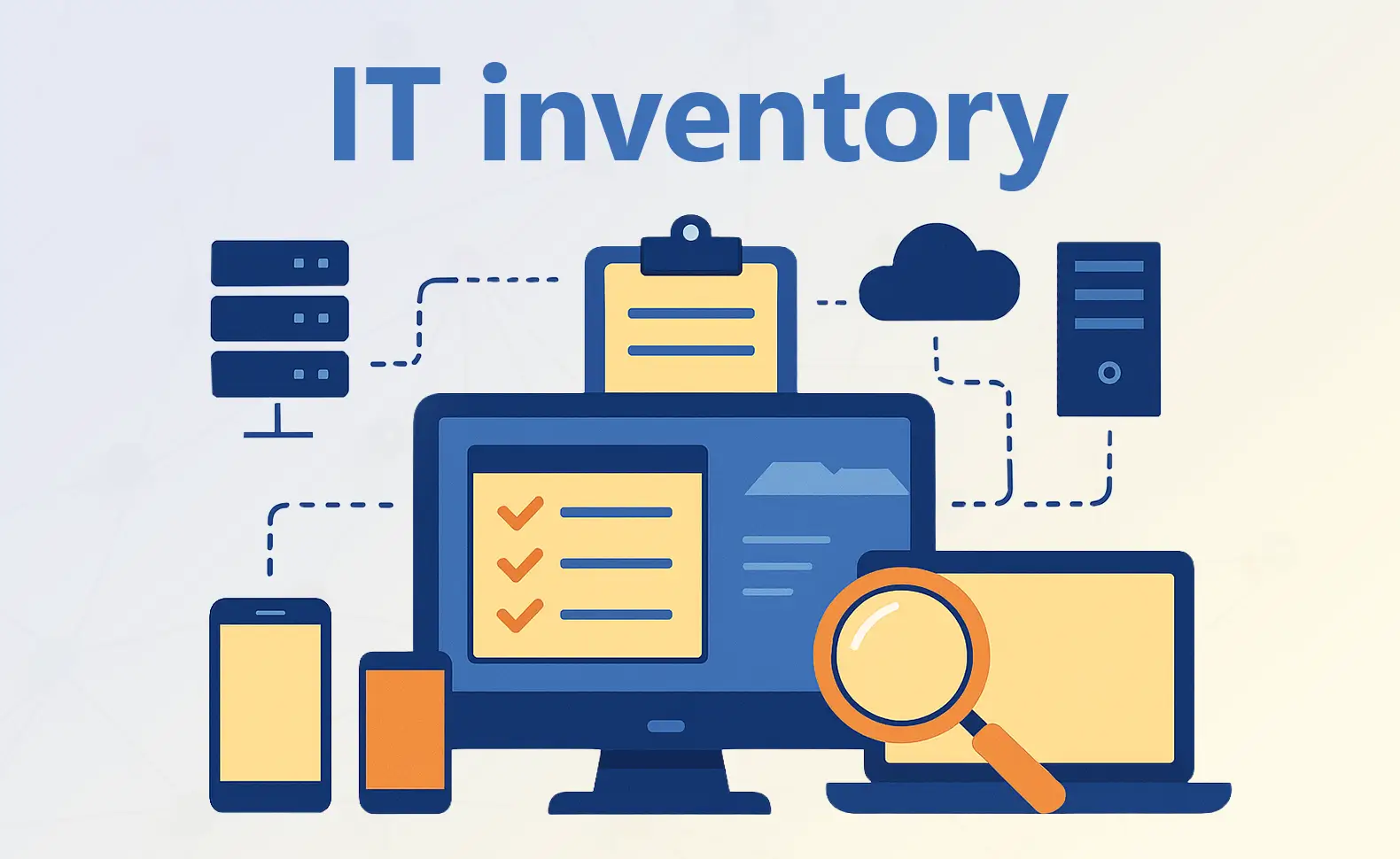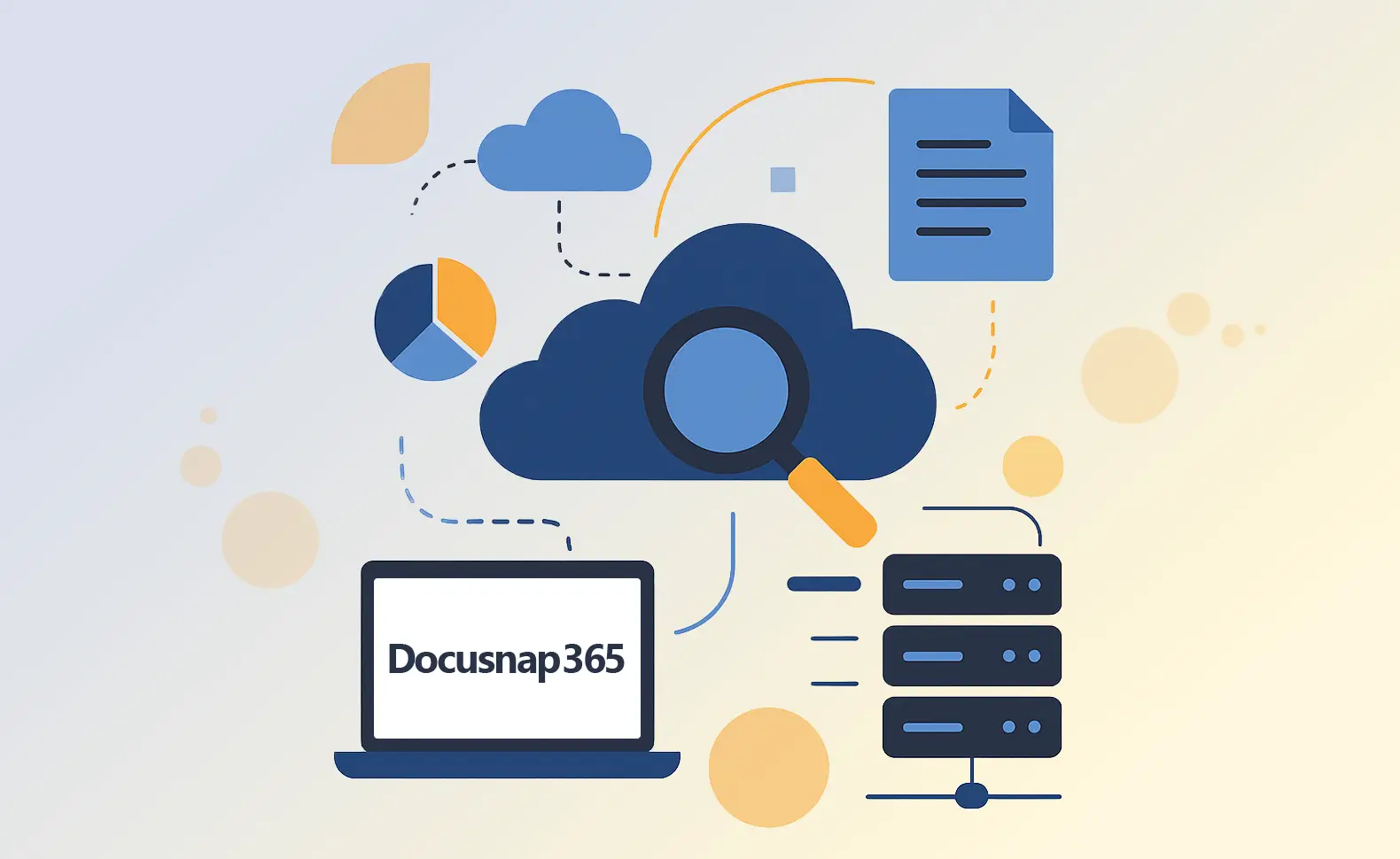The most important thing in brief:
- Transparent inventory: Regular and automated IT inventory uncovers outdated software, security gaps and unused resources and is therefore the basis for smooth processes. Especially in times of growing cyber threats, up-to-date data ensures a decisive advantage in IT.
- Specific cost savings: By uninstalling superfluous software licenses, up to 15% of license costs can be saved, which quickly amounts to a five-digit amount per year with around 100 workstations. As a result, an investment in professional inventory software usually pays off quickly.
- Comprehensive features with Docusnap: Agentless network scans, detailed authorization analyses and integrated license management ensure that all relevant IT assets are recorded and clearly documented. This makes it easier to comply with compliance requirements and reduces daily administrative costs.

Imagine the following scenario: In a medium-sized company with around 200 employees, a system crash suddenly occurs. Server services go crazy, various applications no longer work correctly, and no one can say unequivocally which hardware and software are affected. The IT department is feverishly trying to get an overview, but much information is only available in outdated Excel lists or is spread across different departments. Costly use of experts is necessary to limit the damage and manually check all systems. Management is frustrated as valuable working time is lost and trust in the reliability of the company's own IT infrastructure decreases.
This example impressively shows the importance of professional IT inventory: Without a complete overview of the entire hardware and software landscape, faults are difficult to contain and security gaps often remain undetected for a long time. It is precisely for these reasons that IT inventory is essential for most companies, regardless of whether they are small start-ups or international corporations.
What is IT inventory?
The term IT inventory describes the systematic recording, documentation and analysis of all IT-relevant resources in a company. This includes not only physical devices such as servers, network components, desktops and notebooks, but also virtual machines, operating systems, installed applications and possible cloud services. Especially in times of constantly growing and complex IT landscapes — fuelled by topics such as virtualization, containerization and cloud computing — up-to-date inventory is more important than ever.
The aim of IT inventory is to create an up-to-date and reliable database that serves as a basis for decision-making in many areas, for example:
- Safety management: Identification of outdated software and potential security vulnerabilities.
- Asset management: Tracking hardware over its entire life cycle.
- Cost optimization: Uncovering redundant systems or unused resources to reduce costs
- Compliance: Compliance with legal requirements or industry standards such as ISO 27001.
- License management: Determining license requirements and avoiding under- or over-licensing.
In order for inventory to remain reliable, it must be updated regularly. This is the only way to ensure that the inventoried information always reflects the current status. Continuous and automated data collection is essential, especially in agile companies with high change dynamics. For medium-sized companies, a monthly or quarterly scan cycle is often recommended, while large corporations can even carry out daily or weekly inventories to always stay up to date.
Why is IT inventory necessary?
There are many reasons for professional IT inventory:
- Transparency: Only those who know exactly which systems and applications are available can plan efficiently and react to changes.
- Securety: Regular inventory processes reveal outdated operating systems, insecure configurations, or missing updates more quickly. This allows security gaps to be closed at an early stage.
- Cost savings: Unnecessary software licenses, unused servers or duplicate resources can be identified and reduced through proper IT inventory.
- Compliance: Many industries and legislators require transparent proof of the systems used and their security status. For example, IT inventory helps to meet the requirements of standards such as ISO 27001 to fulfill.
- Everyday efficiency: A well-structured overview of all assets drastically reduces research time in the event of faults or maintenance work.
Without an organized IT inventory, companies risk data loss, missed license deadlines and, in the worst case, serious security incidents. Especially in times of increasing cyber attacks and increasing compliance regulations, IT inventory is therefore an indispensable foundation for stable and secure IT.
Statutory requirements and standards
At European level, the General Data Protection Regulation (GDPR) plays a central role in many industries. Even though the GDPR does not explicitly require every software installation to be documented, it still requires complete information about data processing processes and the protection of personal data. A solid IT inventory makes it easier to provide exactly this evidence.
In addition, industry-specific regulations must be observed in some areas, for example in the financial sector (e.g. DORA) or in healthcare (e.g. Hospital Future Act, KHZG). For companies that comply with common IT security standards such as ISO 27001 or the BSI basic protection (Federal Office for Information Security, BSI), clean documentation of IT systems is mandatory anyway. Here, automated IT inventory not only provides proof, but also actively contributes to reducing security risks.
How can an IT inventory be created?
In order to successfully implement and scale an inventory solution, companies should incorporate best practices into their planning. For example, it makes sense to start in a manageable system environment first and then expand the process in phases, especially for larger structures. For smaller companies, inventory on a monthly or quarterly basis may be sufficient, while larger companies rely on weekly or even daily scans to stay up to date.
There are basically two approaches to IT inventory:
- Manual inventory: You enter all data manually, for example in Excel lists or databases. Although this is inexpensive to buy, it takes a lot of time. There is also an increased risk of errors, as manual inventories quickly become outdated and transmission errors can easily occur.
- Automated inventory: Specialized tools are used here that scan the network and independently identify hardware and software. These tools not only provide much higher accuracy, but usually update the data continuously or at defined intervals. This eliminates a large part of the manual effort and keeps the overview of the IT landscape up to date.
In order to implement inventory sustainably, it is advisable to carry out a pilot phase for automated solutions. It scans small parts of the network and checks them for accuracy. The tool is then rolled out in other areas and processes are constantly optimized.
What should be considered during implementation?
A structured IT inventory is not only a technical project, but also an organizational project. In doing so, the IT department should work closely with management to secure necessary resources and formulate common goals. You should consider the following points:
- Clarify responsibilities: Determine who has administrative rights to use the inventory software and who receives or evaluates the results.
- Schedule regular scans: IT landscapes are constantly changing. Automated updates are important to keep documentation up to date at all times.
- Data protection: Make sure that you only enter system-relevant information. For tools that process personal data, an agreement with the data protection officer is useful.
- Consider interfaces: A good inventory solution should be able to be integrated into existing systems (e.g. ticketing, monitoring).
- Compatibility: Check whether the inventory tool supports your specific operating environments, such as specialized databases, virtualization technologies, or operating systems.
All of these points show how complex the topic is. A professional approach is therefore usually only efficient and successful in the long term with a suitable software solution.
The benefits of Docusnap in the context of IT inventory
When it comes to comprehensive and automated IT inventory, Docusnap stands out as a complete solution. The software collects all relevant information about your IT landscape — from hardware to software — without agents. But the benefits go far beyond a mere inventory:
- Automated, agentless inventory: Docusnap scans your network at defined intervals and constantly updates the data. This means that your inventory data is always up to date without having to make manual entries.
- Clear reports and charts: In addition to lists and tables, Docusnap generates detailed plans, network diagrams and overview reports that present all important information at a glance. This not only makes day-to-day business easier, but also audits and revisions.
- Integrated license management: The license management functions integrated in Docusnap provide valuable insights into your software inventory. Licensing bottlenecks or overlaps can be identified and resolved at an early stage. (More about license management)
- Permission analysis: A special feature is the detailed analysis of authorization structures. If you wish, you can immediately see which users or groups have access to specific folders and shares. This is not only essential for security, but also for compliance checks. (More about authorization analysis)
- Quick deployment and scalability: Thanks to simple installation and agentless operation, Docusnap can be integrated into almost any existing environment. The tool is correspondingly scalable for growing IT structures.
- Convenient documentation: At the push of a button, Docusnap creates meaningful IT documentation, including all network and system-relevant information. There is no need to copy data from different sources together.
All of this makes Docusnap a true all-in-one solution for IT inventory. Instead of having to use many different programs, you get everything from a single source. This creates transparency and reduces sources of error.
Tips for a successful implementation
To get the most out of inventory software like Docusnap, you should consider a few points when introducing it:
- Plan a pilot phase: Start with a small network segment or department to test processes and familiarise employees with reports and analyses.
- Define roles and access rights: Determine who is responsible for managing and maintaining inventory data and which colleagues, for example, only need reading rights.
- Check integrations: Consider which systems or data you want to integrate into Docusnap. The better the network, the more meaningful the inventory results are.
- Schedule training: Even the best software only develops its potential if the team knows how to use it. Introductory training or targeted workshops increase acceptance and competence.
- Evaluate regularly: The hardware and software data obtained is only of any use to you if you also actively evaluate the information. Create regular reports, derive measures and monitor their success.
Automation, cloud and future developments
Another trend concerns cloud integration and the steadily growing use of SaaS solutions. Many companies combine on-premises solutions with cloud services, making asset structures even more complex. A modern IT inventory must be able to comprehensively record hybrid environments and also inventory container or microservice environments.
In future, there will also be AI-powered analytics gain in importance. Automated risk assessments are possible, in which inventory data is evaluated in real time in order to proactively close security gaps. For companies, this means that once an inventory solution has been introduced, it should be able to continuously develop and adapt to new technologies. This is exactly what Docusnap focuses on and is constantly working to improve data analysis and provide new interfaces.
Practical relevance as a success factor
Practical suitability is a decisive point. Many software projects fail because they are too complicated to use or provide too little added value. Docusnap stands out here due to its high level of usability and comprehensive documentation. IT managers get at a glance:
- Network maps: All servers, switches, routers, or virtual machines are displayed graphically. A big advantage when things have to be done quickly, for example in the event of an emergency.
- License status: Where is there a risk of over-licensing or are licenses even missing? Thanks to automatic reconciliation between licensed and installed software, you are always in the know.
- Hardware overview: When do warranties expire? Which devices are in acute need of replacement? Here, too, the stored database is worth its weight in gold.
- Report archiving: Each scanned inventory is historically documented so that changes can be traced.
It is important that the software is not only used once a year, but is integrated into daily or weekly routine processes. The more frequently new data is scanned, the more reliable the overall overview becomes.
Costs at a glance, benefits in focus
Using software such as Docusnap naturally requires an initial investment and regular maintenance. However, companies should clearly compare the benefits of automated inventory. In addition to saving time, you prevent potential license and compliance penalties, reduce security risks and gain a significantly better planning basis for your IT. A brief practical case shows, for example, that just by identifying and uninstalling unused software licenses, a medium-sized company could save up to 15% of license costs — which can quickly amount to a five-digit amount per year with around 100 workstations. This makes the benefits of automated inventory quickly visible compared to the initial investment.
Experience has shown that medium-sized and larger companies in particular achieve the return on investment quickly as soon as many manual process steps are omitted and the data quality is high. In addition, transparent inventories often provide a better negotiating position with suppliers or software manufacturers. Another positive aspect: For many IT employees, satisfaction is increased because they no longer have to carry out time-consuming data maintenance in Excel spreadsheets. Instead, modern dashboards and reports are available that are fun to work with and provide real added value.
Conclusion: IT inventory as a cornerstone of modern IT
Today, a professional IT inventory is more than just an inventory: it is the basis for security, efficiency and vision in your IT. Particularly with regard to legal requirements such as the GDPR or security standards such as ISO 27001, transparency of all assets and processes is becoming increasingly important. Docusnap shows how comprehensive and automated inventory can be designed today — including meaningful documentation, authorization analysis and license management.
Practice shows that not only large corporations but also small and medium-sized companies benefit from the structured approach. A single failure, as in our practical example, can quickly cause high costs and shake the workforce's trust in IT. With automated inventory, you can prevent such scenarios and increase the resilience of your infrastructure. Take advantage of this decisive advantage: Take your IT documentation to the next level and minimize risks with Docusnap's comprehensive features.
Test it now for free
If you want to experience the benefits of Docusnap for yourself, we have another tip: Just try Docusnap free of charge for 30 days. The official website provides quick access to the trial version and further information about all functions, reports and integration options. In practice, you will see how automated IT inventory helps you save time, reduce IT costs and minimize security risks.
In a world where IT infrastructures are developing rapidly and new security threats are being added almost daily, a reliable, accurate and constantly updated inventory is essential. With Docusnap, you are well equipped to keep track of your systems, identify potential threats early on and secure your IT in the long term. In this way, you not only remain able to act, but also secure decisive competitive advantages in an increasingly complex IT environment.
Next steps
Set up agentless inventory using a powerful tool like Docusnap. In this way, you benefit from comprehensive functions such as license management and authorization analysis and can transparently document your IT with just a few clicks. Try Docusnap now free of charge for 30 days and take your IT inventory to the next level.
Try it now for free!


